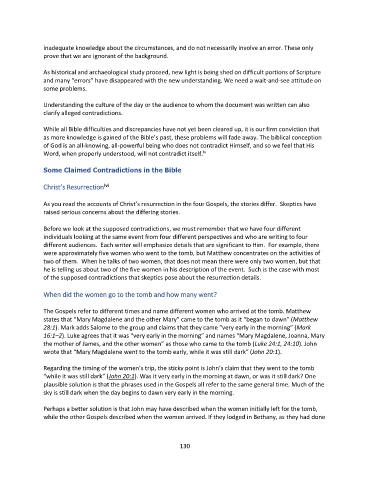Page 132 - Doctrine and History of the Preservation of the Bible revised
P. 132
inadequate knowledge about the circumstances, and do not necessarily involve an error. These only
prove that we are ignorant of the background.
As historical and archaeological study proceed, new light is being shed on difficult portions of Scripture
and many “errors” have disappeared with the new understanding. We need a wait-and-see attitude on
some problems.
Understanding the culture of the day or the audience to whom the document was written can also
clarify alleged contradictions.
While all Bible difficulties and discrepancies have not yet been cleared up, it is our firm conviction that
as more knowledge is gained of the Bible’s past, these problems will fade away. The biblical conception
of God is an all-knowing, all-powerful being who does not contradict Himself, and so we feel that His
lv
Word, when properly understood, will not contradict itself.
Some Claimed Contradictions in the Bible
lvi
Christ’s Resurrection
As you read the accounts of Christ’s resurrection in the four Gospels, the stories differ. Skeptics have
raised serious concerns about the differing stories.
Before we look at the supposed contradictions, we must remember that we have four different
individuals looking at the same event from four different perspectives and who are writing to four
different audiences. Each writer will emphasize details that are significant to Him. For example, there
were approximately five women who went to the tomb, but Matthew concentrates on the activities of
two of them. When he talks of two women, that does not mean there were only two women, but that
he is telling us about two of the five women in his description of the event. Such is the case with most
of the supposed contradictions that skeptics pose about the resurrection details.
When did the women go to the tomb and how many went?
The Gospels refer to different times and name different women who arrived at the tomb. Matthew
states that “Mary Magdalene and the other Mary” came to the tomb as it “began to dawn” (Matthew
28:1). Mark adds Salome to the group and claims that they came “very early in the morning” (Mark
16:1–2). Luke agrees that it was “very early in the morning” and names “Mary Magdalene, Joanna, Mary
the mother of James, and the other women” as those who came to the tomb (Luke 24:1, 24:10). John
wrote that “Mary Magdalene went to the tomb early, while it was still dark” (John 20:1).
Regarding the timing of the women’s trip, the sticky point is John’s claim that they went to the tomb
“while it was still dark” (John 20:1). Was it very early in the morning at dawn, or was it still dark? One
plausible solution is that the phrases used in the Gospels all refer to the same general time. Much of the
sky is still dark when the day begins to dawn very early in the morning.
Perhaps a better solution is that John may have described when the women initially left for the tomb,
while the other Gospels described when the women arrived. If they lodged in Bethany, as they had done
130

